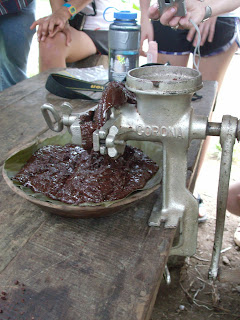1) Cooking and consuming the best egg-in-a-nest of my life in a passive solar oven that another student made for EcoFest, a festival we put on a week ago (cook time: 2 hrs)
2) Got a gig playing at Sushi and Jazz Night at a local hotel last night with my friend Megan, who is an incredible singer. Musicmaking and merrymaking ensued.
3) Took some finals, two more to go.
4) Ate chicharones (fried pig skins) for what will probably be the last time in a long time. They're pretty delicious, but it's hard to shake the notion that one is essentially eating breaded bacon chunks. You can pretty much feel them doing harm to your body.
5) Been seeing motmot birds all over the place. They look like this:
Tomorrow I'm headed to Upala, a rural town where my host grandparents live. It'll be refreshing to get out into the country and relax after all our finals are done. Then I come back to MV to pack and Monday will find all of us traveling once more back to Alajuela, where we will part ways, some to travel in CR and Nicaragua and others to take that northing flight home. My six hour layover in Dallas will be quite a change from 3 months spent in almost constant contact with either fellow students or my host family. I think I'll probably buy a crossword puzzle book to pass the time (I have become addicted to NYtimes crosswords here, thanks to my friend Leah).
Anyway, I never got around to posting about our time with the BriBri near the Panamanian border, so here goes. Centuries ago, the BriBri lived in what is now Panama, but they migrated Northward over time, largely to avoid Spanish settlement. This migration led them into more and more mountainous terrain (where Spaniards didn't see it as worth it to pursue), and the community we visited, Yorkín, is located along a river in the foothills of the Talamanca Mountains.
To get to Yorkín, we piled into well-worn canoes equipped with 15 horsepower outboard motors, each with a motor-operator in the stern and a poler in the bow. These guys worked harder than anyone I have ever seen in my life, masterfully guiding the canoe through what seemed like the only navigable channel in an extremely shallow river, with the motor guy bodily lifting the motor out of the water in rocky patches to prevent propellor damage (they have to replace their propellors twice a year).
When we got to Yorkín, many of us were surprised to see another group of extranjeros staying in the community, but we soon found out that a women's group in the community started an ecotourism organization in the 1990s called STIBRAWPA (BriBri for women artisans), which has been largely responsible for a marked upswing in socioeconomic opportunities in the region. They are visited by 1000 people each year.
STIBRAWPA was formed following the mass exodus of the BriBri workforce from Yorkín that was the result of the advent of the monilia fungus, which reduced annual cacao yield (their primary cash crop) by up to 70%. Most of the men of the community were forced to seek work elsewhere, and (predictably) they found it on banana plantations and oil refineries, where their daily proximity to chemicals had sweeping adverse health effects. However, the rise of STIBRAWPA expanded the cacao/banana agroforestry system to include ecotourism dollars, which has stabilized the local economy and allowed most of these men to return. Furthermore, women have gained a lot of respect in the community and have made great strides in reducing the influence of machisto culture in the region.
Tourists who come to the area often come for just one day, but some (like us) stay for 4 days to a week. Visitors experience first hand the process of turning cacao fruit into chocolate, take a BriBri language lesson, eat meals cooked by wood fire in an open air dining room, and many do some volunteer work (we helped continue the building of a new trail), all the while getting to know the area and the people of Yorkín.
One can see the strange pressures of indigenous authenticity at work. On our second to last afternoon, a teenager wearing a Nike brand tanktop and flat-brimmed backwards baseball cap was teaching a middle-aged French nurse how to use a bow and arrow (it was unclear to me in all our time there if the BriBri even use bows and arrows). As I was watching in the dining area, one of the BriBri women who was taking a break from the kitchen answered a cell phone that was blasting a Shakira ringtone. It is unfair for tourists to expect total cultural isolation and preservation, yet its subtle influences are evident, and even more curiously, if one looks a little closer, it is apparent that the BriBri are well aware that what they are selling is their culture, and they take many subtle steps to highlight their indigenous identity.
That's about all she wrote for now. I'll close out the blog with a final post when I return stateside early next week. Thanks to all of you who kept up, and sorry for the long lapses in posting. It's been a fun jaunt in the blogosphere, though I am not sure if it's a medium I'm cut out for, ha. This last picture is of our logistics coordinator, Rolo, who organized both trips we took this semester. He is kind of like a Tico uncle to me, and is one of the people I will miss the most when I come back home. I hope you all are well.



No comments:
Post a Comment